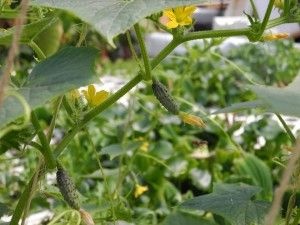
One of my first experiences on a farm opened my eyes to the fascinating interconnectedness of an agricultural system. For this reason, I find it truly rewarding to share in people’s excitement when they visit the aquaponics project. It was on that first farm visit that I realized agriculture meant more than growing a head of lettuce in a faraway field; it meant growing and nurturing a community of organisms, from the chickens that fertilize the soil to the microbes that break down their waste and the people that consume the food. Aquaponics takes these relationships out from hiding. From avid home gardeners to those who have never before seen vegetables in the field, visitors to the greenhouse witness the symbiosis between the fish, the plants and the microorganisms in the system, and feel inspired. Like many forms of sustainable agriculture, aquaponics attempts to harness these relationships to create an efficient, low-input system that promises something better than the industrial paradigm.
The aquaponics system looks clean and high-tech: modern compared to growing crops in soil. It is easy to become swept up in the excitement, and I am often asked why agriculture has not yet abandoned its soil-bound roots for the sophistication of the aquaponics greenhouse. However, while aquaponics has some unique aspects that make it an innovative solution for particular situations, it is not inherently better than soil-based agriculture. Farming is hard work in the best of times and aquaponics is no exception. In addition, soil-based agriculture can provide some truly innovative, regenerative solutions to the environmental and human health problems posed by the industrial system without ever leaving the ground.
On my first farm visit all those years ago, I witnessed the same miracles of aquaponics, but in the soil. Livestock and plants coexist in much the same way as fish and vegetables do in aquaponics. Look close enough, and you’ll see that a single teaspoon of soil can be home to up to one billion bacteria, plus additional fungi, protozoa and nematodes, and we are only just beginning to understand the diverse roles these organisms play in plant growth, nutrient uptake, carbon sequestration, and even communication. Similar to aquaponics, soil-based agricultural systems can be designed to capitalize on the benefits of biodiversity and natural ecosystem services. From intercropping to rotational grazing, the use of swales to retain water or the planting of habitat for beneficial insects, the complexity of relationships and creative innovations on a soil-based farm are awe-inspiring.
In essence, aquaponics has taken inspiration from these complex agroecological systems developed over thousands of years and boiled them down to a handful of biological moving parts replicable in a highly controlled greenhouse environment. Aquaponics offers the advantage of being a space and water efficient method of producing both produce and protein, but it also an energy intensive system that relies heavily on inputs (fish food, heating, water amendments, plastic components) that is far from the ideal “closed loop” of a functioning natural ecosystem. While aquaponics farms offer a visually intriguing, space-efficient alternative that can compliment the growth of sustainable soil farming, as with any farm it is important to continue to challenge imperfect practices and work towards a more productive, resource conserving, and resilient agroecosystem. Aquaponics has a lot to offer in areas where farmland and open spaces are scarce, but aquaponics is no more a marvel of agricultural ingenuity than many innovative, small-scale soil-based farms, despite the high tech appearance. Instead of reducing natural systems to their most basic elements, aquaponics should continue to strive to resemble a natural system (much like a pond or estuary) full of complexity, diversity of life, and habitat for organisms beyond just food crops.



